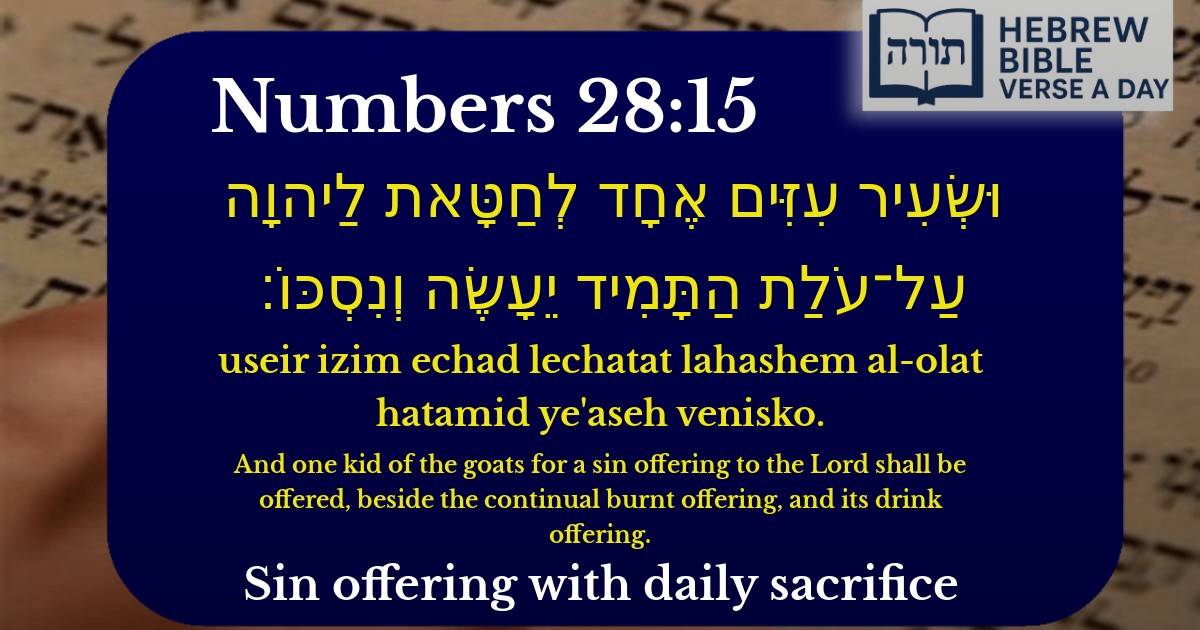Frequently Asked Questions
Q: What is the 'sin offering' mentioned in Numbers 28:15?
A: The 'sin offering' (חַטָּאת) in Numbers 28:15 refers to a goat sacrificed to atone for unintentional sins. According to Rashi, this was an additional offering brought on Rosh Chodesh (the new month) alongside the daily Tamid offering. The Talmud (Chullin 60b) explains that sin offerings help achieve atonement and maintain the sanctity of the Mishkan (Tabernacle) and later the Beit Hamikdash (Temple).
Q: Why does Numbers 28:15 mention a 'continual burnt offering'?
A: The 'continual burnt offering' (עֹלַת הַתָּמִיד) refers to the daily sacrifices offered morning and evening in the Mishkan and later the Beit Hamikdash. Rambam (Hilchot Temidin uMusafin 1:1-3) explains that this offering symbolizes the Jewish people's constant devotion to Hashem. The verse teaches that even on special occasions like Rosh Chodesh, the daily offering must not be interrupted.
Q: What is the significance of the drink offering in Numbers 28:15?
A: The drink offering (נִסְכּוֹ) consisted of wine poured on the altar alongside certain sacrifices. Rashi explains that it symbolizes joy in serving Hashem. The Talmud (Menachot 104b) teaches that the wine libation completes the sacrifice, just as joy completes one's service of G-d. This teaches us that our mitzvot should be performed with happiness and completeness.
Q: How does Numbers 28:15 apply to Jews today without a Temple?
A: While we cannot bring sacrifices today without the Beit Hamikdash, the verse teaches important principles. Rambam (Moreh Nevuchim 3:46) explains that sacrifices were meant to direct our hearts to repentance. Today, we fulfill this through prayer (Tehillim 141:2 compares prayer to offerings), Torah study (Menachot 110a equates learning about sacrifices to bringing them), and acts of kindness (Hoshea 14:3). The verse reminds us of our constant connection to Hashem.
Q: Why does the Torah specify a goat for the sin offering in this verse?
A: The goat was chosen for this sin offering based on Hashem's command. Rashi notes that goats were commonly used for sin offerings (Vayikra 4:23). The Midrash (Bamidbar Rabbah 21:11) explains that goats symbolize atonement, recalling how Yaakov used goatskins to receive blessings (Bereishit 27:16). This teaches that sincere repentance, represented by the offering, can transform our 'goat-like' stubbornness into devotion.


The Sin Offering Alongside the Tamid
The verse (Numbers 28:15) discusses the requirement to bring a goat as a chatat (sin offering) in addition to the daily tamid (continual burnt offering). Rashi explains that this refers to the additional sin offering brought on Rosh Chodesh (the New Moon), which accompanies the regular tamid sacrifices. The Talmud (Chullin 60b) notes that this emphasizes the importance of atonement even during times of regular service.
Purpose of the Chatat
Rambam (Hilchot Temidin uMusafin 10:1) teaches that the sin offering serves as atonement for possible unintentional sins committed in the Temple or regarding sacred things. The goat is specifically chosen because, as the Midrash (Bamidbar Rabbah 21:18) suggests, it recalls the merit of Yaakov Avinu, who prepared goats for his father Yitzchak (Genesis 27:16), symbolizing repentance and rectification.
The Connection to the Tamid
The phrase "al olat hatamid" ("beside the continual burnt offering") indicates that this sin offering is secondary to the tamid. The Kli Yakar explains that this teaches that while atonement is necessary, the primary focus must always be on the consistent daily service of Hashem, represented by the tamid. The sin offering supplements but does not replace the ongoing dedication symbolized by the tamid.
The Nesachim (Drink Offering)